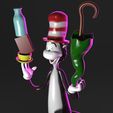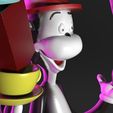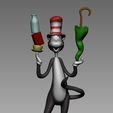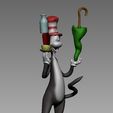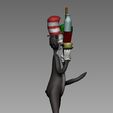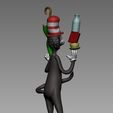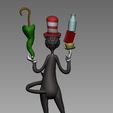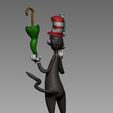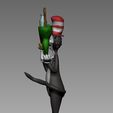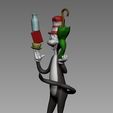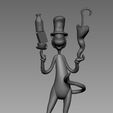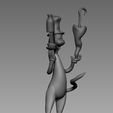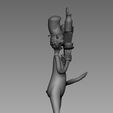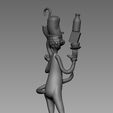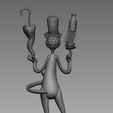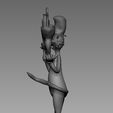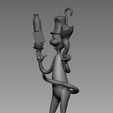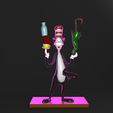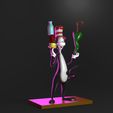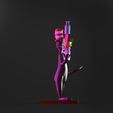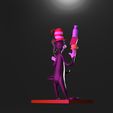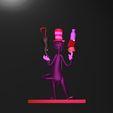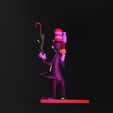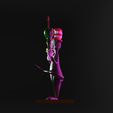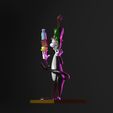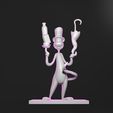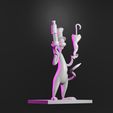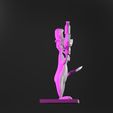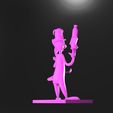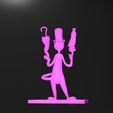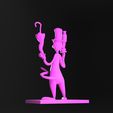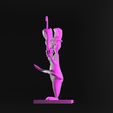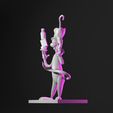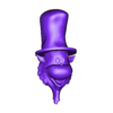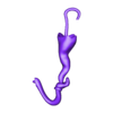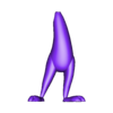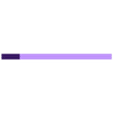The Cat in the Hat
Author Dr. Seuss
Illustrator Dr. Seuss
Country United States
Language English
Genre Children's literature
Publisher Random House, Houghton Mifflin
Publication date March 12, 1957
The Cat in the Hat Comes Back (plot wise)
The Cat in the Hat is a 1957 children's book written and illustrated by American author Theodor Geisel, using the pen name Dr. Seuss. The story centers on a tall anthropomorphic cat who wears a red and white-striped top hat and a red bow tie. The Cat shows up at the house of Sally and her brother one rainy day when their mother is away. Despite the repeated objections of the children's fish, the Cat shows the children a few of his tricks in an attempt to entertain them. In the process, he and his companions, Thing One and Thing Two, wreck the house. As the children and the fish become more alarmed, the Cat produces a machine that he uses to clean everything up and disappears just before the children's mother comes home.
Geisel created the book in response to a debate in the United States about literacy in early childhood and the ineffectiveness of traditional primers such as those featuring Dick and Jane. Geisel was asked to write a more entertaining primer by William Spaulding, whom he had met during World War II and who was then director of the education division at Houghton Mifflin. However, because Geisel was already under contract with Random House, the two publishers agreed to a deal: Houghton Mifflin published the education edition, which was sold to schools, and Random House published the trade edition, which was sold in bookstores.
Geisel gave varying accounts of how he created The Cat in the Hat, but in the version he told most often, he was so frustrated with the word list from which he could choose words to write his story that he decided to scan the list and create a story based on the first two rhyming words he found. The words he found were cat and hat. The book was met with immediate critical and commercial success. Reviewers praised it as an exciting alternative to traditional primers. Three years after its debut, the book had already sold over a million copies, and in 2001, Publishers Weekly listed the book at number nine on its list of best-selling children's books of all time. The book's success led to the creation of Beginner Books, a publishing house centered on producing similar books for young children learning to read. In 1983, Geisel said, "It is the book I'm proudest of because it had something to do with the death of the Dick and Jane primers."
Since its publication, The Cat in the Hat has become one of Dr. Seuss's most famous books, with the Cat himself becoming his signature creation, later on becoming one of the mascots for Dr. Seuss Enterprises. The book was adapted into a 1971 animated television special and a 2003 live-action film, and the Cat has been included in many Dr. Seuss media.
Plot
The story begins as an unnamed boy who is the narrator of the book sits alone with his sister Sally in their house on a cold and rainy day, staring wistfully out the window. Then they hear a loud bump which is quickly followed by the arrival of the Cat in the Hat, a tall anthropomorphic cat in a red-and-white-striped top hat and a red bow tie, who proposes to entertain the children with some tricks that he knows. The children's pet fish refuses, insisting that the Cat should leave (namely because their mother would be upset that they are talking to a stranger who has no permission to be in the house and is, therefore, trespassing). The Cat then responds by balancing the fish on the tip of his umbrella. The game quickly becomes increasingly trickier, as the Cat balances himself on a ball and tries to balance many household items on his limbs until he falls on his head, dropping everything he was holding. The fish admonishes him again, but the Cat in the Hat just proposes another game.
The Cat brings in a big red box from outside, from which he releases two identical characters, or "Things" as he refers to them as, with blue hair and red suits called Thing One and Thing Two. The Things cause more trouble, such as flying kites in the house, knocking pictures off the wall and picking up the children's mother's new polka-dotted dress. At this point, the boy begins to understand the fish's aversion to having them and the Cat in the house. All this comes to an end when the fish spots the children's mother out the window. In response, the boy catches the Things in a net and orders the Cat to take them away and leave. Apparently ashamed, he stores them back in the big red box. He takes it out the front door as the fish and the children survey the mess he has made. But the Cat soon returns, riding a machine that picks everything up and cleans the house, delighting the fish and the children. The Cat then leaves just before their mother arrives, and the fish and the children are back where they started at the beginning of the story. As she steps in, the mother asks the children what they did while she was out, but the children are hesitant and do not answer. The story ends with the question, "What would you do if your mother asked you?" (though it is implied that they do not tell her about the Cat, as she does not seem to know about him by the next book)
El gato en el sombrero
El gato en el sombrero regresa (en cuanto a la trama)
El gato en el sombrero es un libro infantil de 1957 escrito e ilustrado por el autor estadounidense Theodor Geisel, utilizando el seudónimo de Dr. Seuss. La historia se centra en un gato antropomórfico alto que viste un sombrero de copa a rayas rojas y blancas y una pajarita roja. El Gato aparece en la casa de Sally y su hermano un día lluvioso cuando su madre no está. A pesar de las repetidas objeciones del pez de los niños, el Gato les muestra algunos de sus trucos en un intento de entretenerlos. En el proceso, él y sus compañeros, Cosa Uno y Cosa Dos, destrozan la casa. A medida que los niños y los peces se alarman más, el gato produce una máquina que usa para limpiar todo y desaparece justo antes de que la madre de los niños llegue a casa.
Geisel creó el libro en respuesta a un debate en los Estados Unidos sobre la alfabetización en la primera infancia y la ineficacia de las cartillas tradicionales como las que presentan Dick y Jane. William Spaulding, a quien había conocido durante la Segunda Guerra Mundial y que entonces era director de la división de educación en Houghton Mifflin, le pidió a Geisel que escribiera un manual más entretenido. Sin embargo, como Geisel ya tenía contrato con Random House, los dos editores llegaron a un acuerdo: Houghton Mifflin publicó la edición educativa, que se vendió a las escuelas, y Random House publicó la edición comercial, que se vendió en librerías.
Geisel dio distintos relatos de cómo creó El gato en el sombrero, pero en la versión que contó más a menudo, estaba tan frustrado con la lista de palabras entre las que podía elegir palabras para escribir su historia que decidió escanear la lista y crear una historia basada en las dos primeras palabras que riman que encontró. Las palabras que encontró fueron gato y sombrero. El libro obtuvo un éxito comercial y de crítica inmediato. Los críticos lo elogiaron como una alternativa interesante a las imprimaciones tradicionales. Tres años después de su debut, el libro ya había vendido más de un millón de copias y, en 2001, Publishers Weekly lo incluyó en el puesto número nueve de su lista de libros infantiles más vendidos de todos los tiempos. El éxito del libro llevó a la creación de Beginner Books, una editorial centrada en la producción de libros similares para niños pequeños que aprenden a leer. En 1983, Geisel dijo: "Es el libro del que estoy más orgulloso porque tuvo algo que ver con la muerte de las cartillas de Dick y Jane".
Desde su publicación, El gato en el sombrero se ha convertido en uno de los libros más famosos del Dr. Seuss, y el propio gato se convirtió en su creación distintiva y más tarde se convirtió en una de las mascotas de Dr. Seuss Enterprises. El libro fue adaptado a un especial de televisión animado de 1971 y a una película de acción real de 2003, y el Gato ha sido incluido en muchos medios de Dr. Seuss.

/https://fbi.cults3d.com/uploaders/26916960/illustration-file/c56dc709-71b4-4455-8757-e8c958f3ec46/cat.565.jpg)
